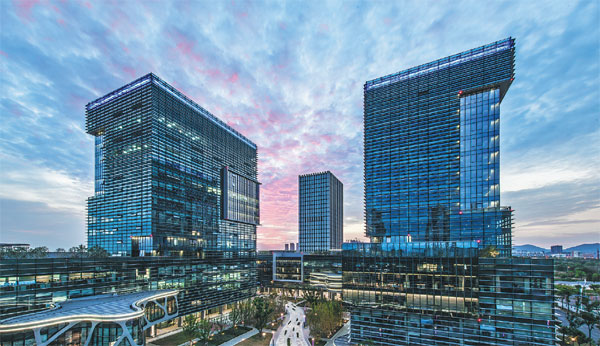Nanjing Jiangbei New Area soars to historic heights
Innovative district brings growth and new industry to ancient capital
Nanjing, capital of East China's Jiangsu province, was the nation's capital for more than 450 years, and its 2,500 years of history runs deeply through the city's veins. However, Nanjing is not resting on its past glories and is instead forging a new path.
Nanjing's Jiangbei New Area is a shining example of the city's potential for expansion, especially in the intelligent manufacturing and cutting-edge technology sectors.


From Left: The factory of Taiwan Semiconductor Manufacturing Co in the Jiangbei New Area of Nanjing, capital of East China's Jiangsu province. Teng Hongfei / For China Daily Sunset between two buildings. Ma Aihua / For China Daily Nanjing Youth Olympic Games Sports Park. Liu Ning / For China Daily Thousands of lights illuminate the new area at night. Zhang Min / For China Daily
Established in June 2015, the new area covers an area of 788 square kilometers and boasts a group of State-level and provincial industrial parks such as the Nanjing New and High Technology Industry Development Zone and the Nanjing Cross-Strait Technology Industry Park.
Located at the intersection of the Yangtze River and the country's eastern economic powerhouses, the new area is aimed at pushing forward the development of the Yangtze River Delta region, thus creating a new growth engine in China's coastal regions.
Over the past three years, the new area has been gathering momentum for growth.
In 2015, its GDP was 146.5 billion yuan ($21.1 billion). One year later, this number hit 183.9 billion yuan, an increase of 25 percent, putting the new area in the second place among all State-level new areas in terms of the growth rate.
In 2017, its GDP topped 200 billion yuan with major economic indicators above the average of both the province and the city.
According to the director of the emerging industry office of the region's economic development bureau, the integrated circuit industry is maintaining exponential growth and its annual output is expected to exceed 10 billion yuan in 2018.
The area has enjoyed stable economic growth from January to September. Its GDP in the past three quarters increased by 13 percent.
Industrial enterprises whose annual revenue exceeds 20 million yuan have experienced an increase of 29.8 percent in GDP over the same period of last year. The area's social fixed-asset investment grew by 16 percent compared to the same period and 23 percent of the increased amount stemmed from industrial investment.
Since the beginning of this year, the new area has paid great attention to the construction of major projects. About 86 projects are in the pipeline with an investment of 32.1 billion yuan.
In early October, another 22 projects surrounding a few pillar industries including intelligent manufacturing and healthcare were being set up.
More than 50 major events have been held in the area, including an annual meeting on semiconductors and a forum on the development of China's financial tools.
From January to September, a total of 260 projects have been launched with a total investment of 160.2 billion yuan.
"Jiangbei New Area's advantages include having a clear goal, a healthy environment, great creativity and improved industrial structure," said Luo Qun, deputy secretary of the Party working committee of the Jiangbei New Area.
The new area is shaping itself into a hub of chip and genome technologies as well as a financial center.
Most of the top 10 integrated circuit design companies in China have branches in the new area. Also based in the area are more than 100 suppliers and manufacturers in the integrated circuit industry.
According to the local government, the new area is home to a national healthcare data center. About 700 healthcare companies have clustered there to form Asia's largest gene-sequencing base, whose output value is set to reach between 60 billion and 70 billion yuan in 2018.
The development of asset management, equity investment, financial technology and other emerging financial industries is encouraged in the area. As a result, over 20 new financial institutions have established their bases there, data from the local government showed.
The new area is also striving to be a modern, international and innovation-oriented demonstration zone, Luo said.
The area's core zone features a central business district, a healthcare district and an industrial research and development park.
Better resources in education, public services and medical care will be available to residents in the new area and its neighboring areas. A total of 34 educational institutions will be put into operation, including Harrow School, Thomas Jefferson School and Gulou Kindergarten.
National first-rate medical hospitals and institutions, such as the Fourth Affiliated Hospital with Nanjing Medical University, an oncology center and a diabetes research center, will be set up to form a medical service center.
The first bridge across the Yangtze River connecting northern and southern Nanjing was not built until 1968, but the area now has 11 river crossings, including bridges and tunnels. Another 24 are planned with two being built each year.
Xiang Lin contributed to the story.








